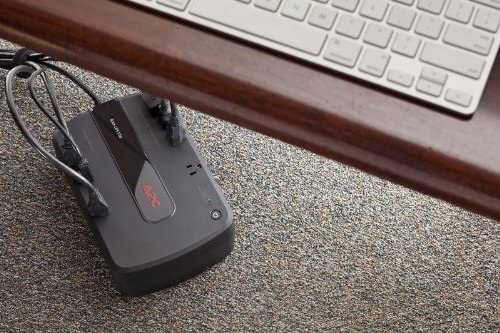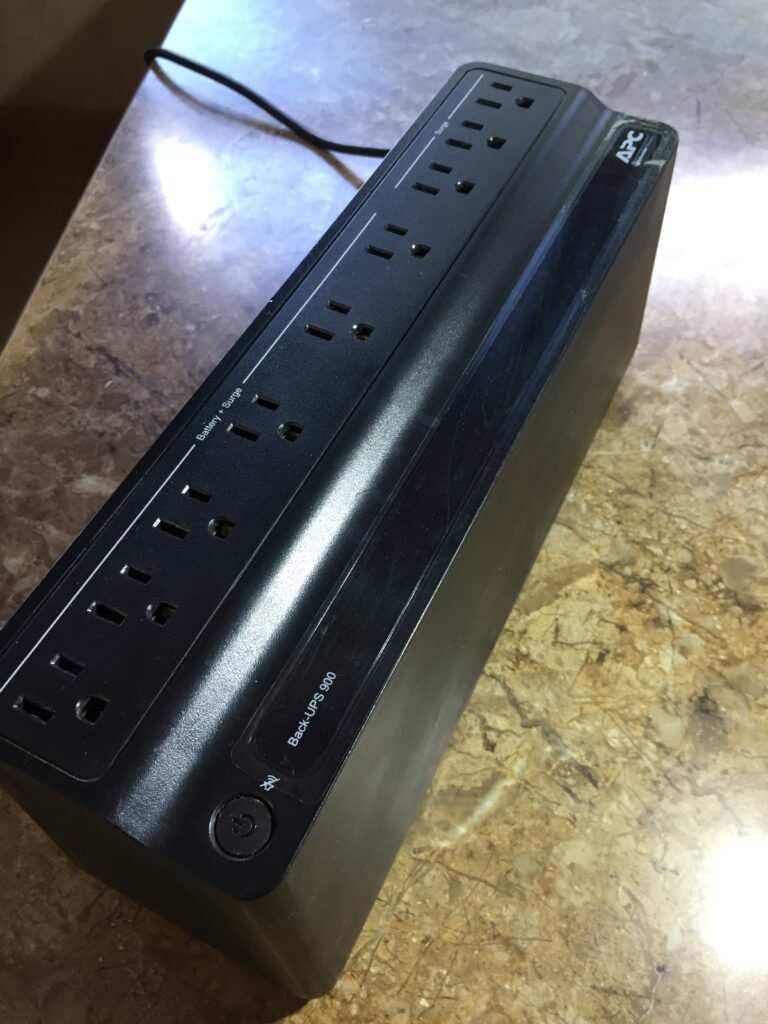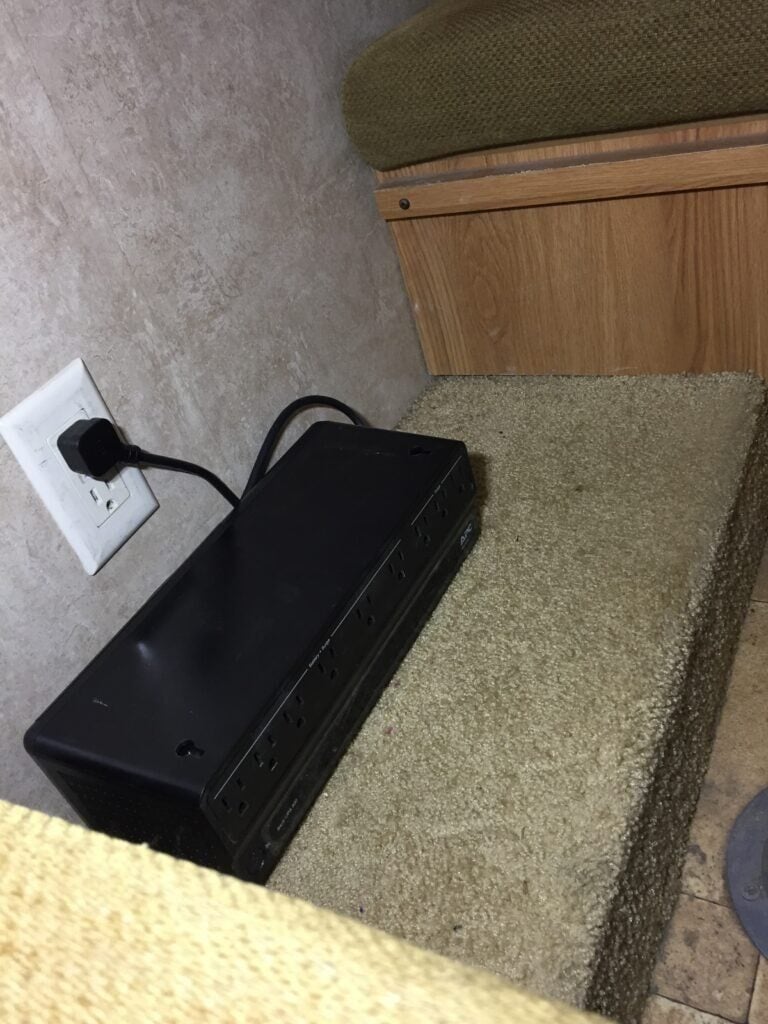
This Office Product Will Enhance Your Dry Camping Experience
I recently had a large credit at an office supply chain store I had to use or lose before we headed out on an extended RV trip. While most of it was spent on office supplies, there is only so much paper and toner you can stockpile before I was wondering what to do with the balance of the credit.
I began to think what can I find at an office supply store that is going to enhance my camping experience away from home in the boondocks? Wandering the aisles, I came up with two things: first was another wireless camera that would allow me to keep eyes on my home while my wife and I are away. I wrote about this previously in an entry concerning keeping your home safe while you are away.
The next thing I stumbled across was something I would have never thought of but has proved very useful during our last extended RV trip. It is a backup power supply with surge protection designed to keep computers and modems functioning and protected during lightning storms and power outages. As an RVer, envision it as a ready supply of low wattage (480 watts) shore power whenever you need it.

The author’s unit. All photos by Dave Helgeson (RV LIFE)
Using a UPS unit (Uninterrupted Power Supply)
It’s perfect for powering any low wattage 120-volt item rather than starting up and listening to your generator, plus you aren’t consuming any amperage out of your battery bank.
Here’s a list of the items I have found it useful for while dry camping:
-
-
- Powering a Waterpik which was recently recommended by my dentist
- Powering/charging my laptop computer
- Powering the 120-volt tuner for our satellite TV receiver
- Charging the battery in my wife’s SLR camera
- Charging the lithium battery in my cordless drill
- Charging my cell phone battery via the standard wall charger rather than a car charger
-

The unit kept under the dinette table
I keep the unit plugged in under the dinette in my RV so anytime I am hooked to shore power (rarely) or running my generator, the power supply charges back-up and is ready for the next use. Also, even when I am on shore power or running the generator, I plug my laptop or other delicate electronics into it for added protection via the built-in surge protector.
Now I could accomplish most of the same benefits via an inverter and upgraded batteries/wiring in my RV, but for under $100 (though I received it free) it is an inexpensive alternative. Plus, it’s portable, allowing me to take it outside into the campsite if desired.
Using office supply equipment to enhance my dry camping experience, just another adventure in RVing! We also recommend having these 7 Useful Items For Dry Camping Without Power.

…interesting, and as a former Office Supply store owner, I remember the ‘days’ when these things were in big demand, as the ‘desktop’ phase of the mid to late 80’s were ‘demanding’ backup power for all those ‘business computers’, like the IBM PC 8088 and the like – you couldn’t have your computer just suddenly cutting off when you have YET to save your data!!
and yes, for the RVing community, this is actually a very efficient way to bypass the need for a generator for some smaller activities that might otherwise draw down the house batteries – these ‘power supplies’ could easily power the computers, device chargers, fans, and even TVs and sat receivers – it’s basically an inverter with it’s own battery supply : ) Nice.
I’m getting one tomorrow!
They are not designed for that purpose. Ur better off going solar with proper deep cycle batteries and not lugging around a 100 lb boat anchor…. Lol
Geez, this would be the perfect thing to keep my CPAP plugged into while on the road!
The 650VA unit is rated to run 100W for 29 minutes. Better to get an inexpensive true sine wave inverter, like a Renogy, for $200 and run off your battery bank.
Yes, a UPS is really just an inexpensive inverter with a few limitations.
It can’t supply a great deal of amperage for high-current devices like a fry-pan or a toaster.
But, more importantly, most inexpensive UPS units do not supply true sine wave power. The waveform they produce is closer to a square wave which can damage some sensitive electronic equipment. It isn’t easy to determine which devices need true sine and which don’t. But, if one of your devices starts misbehaving, that is probably the reason.
I have a 600 watt pure sine wave UPS that usually sits at home backing up my cable modem, router, and Magic Jack so I will have internet and phone service when the power goes out.
When camping, it goes in the camper to supply low draw items when I don’t want to start the generator.
Interesting stuff, thanks. Anyone know if such a device would power a sat receiver and a modest flatscreen? For how long?
What is the product name and what store(s) sell them (Amazon? Office Depot?) Second question: can it be charged while driving off of an inverter plugged into the 12 v cigarette type outlet of your motor vehicle?
Thanks for the interesting article and idea.
To get a rough* idea how long the UPS will power your receiver, tuner, TV, etc take the total watt output of the UPS and divide by the total watt consumption of the items you want to operate. Example 400 watt output divided by 200 watts of consumption equals 2 hours of run time. *The reason I say rough is there are many variables involved that may impact your results.
This is a year old, but I don’t think anybody answered you. They are sold by 2 companies APC and Tripp -Lite.
Battery stores may carry them and that might be cheaper than office stores. This size UPS is powered by small cube shaped batteries, more powerful versions just have more of the same battery. The UPS has 2 rows of
4 or 5 3 prong plug ports, one side is surge protected only, no battery backup, the other side does both. I have 8 in my office. One night the power went out. An electrical contractor was sitting at my desk. There are 24 fluorescent fixtures in the office…6 had 1 bulb lit. The contractor said that was impossible. We walked outside no nearby businesses had any lights.
When camping, it goes.
Most of those little inverters that you buy at WalMart are only 100w to 120w. That’s because the 12vdc from the convenience outlet is typically fused at 15amp or less. I can’t even charge my laptop on one of those things.
To do what you’re asking, you would need an inverter of more than 200w, perhaps even 500w, depending on how much AC the UPS draws. Those are usually wired directly to the battery.
I am really in need of this info about learning how to dry camp using some skills relative to watts and voltage in my RV. I have two installed solar panels which load watts to my four six volt battery bank. I have not figured out how much I can run off that without using generator.
Please send more posts about this mysterious stuff!!
UPS backups are just that, backups. After 30-40 minutes of use they’re dead. Not enough to justify lugging it around IMO. If you need more reserve power it would make more sense to beef up your battery bank instead. And if you want surge protection, why not buy a shore power surge protector and protect the entire camper?
Mike:
The concepts are really simply, but the math can get a little tricky.
Motorhome Electronics 101.
Electrical power comes in two general forms:
AC (alternating current):
usually created by a generator
can be easily stepped up or stepped down using a transformer
can be also be made from DC using an Inverter
DC (direct current)
usually created by a battery or solar panel
can also be made by rectifying and filtering AC through a Converter or “Power Supply”
In a motorhome, you might have 3 sources of AC:
shore power
house generator
inverter
You might have 5 sources of DC:
house batteries (when charged)
cab battery (when charged)
cab alternator (with engine running)
solar panels (when sun present)
converter (when AC is available)
An inverter takes DC power from a battery and creates AC power. They come in two flavors: Modified Sine is much cheaper but True Sine is kinder to your sensitive electronic devices. Most inverters are only about 88% efficient. 100W of DC in yields only about 88W of AC out.
I can talk about my setup because I’ve measured real life draw with a SOC meter. I wanted a full 30A of AC available at all times for things like my gas/elec reefer and laptop charging. I decided to buy a 3000 watt true sine inverter and build it into my motorhome permanently. It came with an integrated AC-DC converter so it charges my house batteries faster than the converter that came with the rig (which I disconnected).
I hired a welder to expand the battery holder under the stairs to hold 4 AGM batteries. Now I have 400ah (amp-hours) of power to use for DC appliances and AC appliances. To get maximum longevity, I try to never let them get below 50%, so I really only have 200ah useable.
What can you do with 200ah? Not much, but really just enough.
Air Cond = 1.6 hr
Reefer = 7.5
Inverter overhead (waste) = 52
DC TV = 55
Laptop charger = 57
Dashboard radio = 133
So, you can see that the inverter is useful, but it isn’t going to do everything. Running the AC will wipe out your batteries in a few heartbeats, so never do it. If you are going to cook something on the microwave, try to keep it under 5 minutes. A toaster is fine because it shuts off after a few minutes. Low current devices can run a long time. Things like a laptop charger, TV, or radio can stay on all night without depleting the batteries.
The best thing about having a whole-house inverter is that we can run the reefer while rolling down the road. Our typical draw underway is about 500W including a radio and a TV, but the vehicle alternator more than makes up for that. Once we get a few solar panels installed, we’ll be able to charge even faster on a sunny day.
so if i dont have shore power, i just plug this in to a 120 volt outlet and it will let me watch tv on my satellite? some one please let me know. thanks
The most popular makers of small UPS devices are:
APC (now owned by Schneider Electric)
Cyberpower (found at MicroCenter)
Tripp-Lite
If you go to their websites, you can find a sizing calculator based on wattage and time.
But, IMO, this is a terrible way to provide AC service in an RV. You would be better off getting a good sine-wave inverter that connects to the house batteries. There are MANY on Amazon. Your house batteries get recharged as soon as you connect to shore power, run your generator, or drive down the road.
To get a rough* idea how long the UPS will power your receiver, tuner, TV, etc take the total watt output of the UPS and divide by the total watt consumption of the items you want to operate. Example 400 watt output divided by 200 watts of consumption equals 2 hours of run time. *The reason I say rough is there are many variables involved that may impact your results.
I work in the computer networks field and we have LOTS of the UPS units – not as small as the unit being described, but still the same concept.
The batteries inside the units are generally SLABs – Sealed Lead Acid Batteries that are made as cheaply as possible. They generally last 2-3 years. So when – not if, but when – the unit no longer holds a charge DO NOT just throw it away. We don’t need more e-waste in the landfills. Just look carefully at the packaging and find the screws or clips that hold the case together. Open it up and get the number off the battery and take a cellphone photo. Order a new battery and swap it out, using your cellphone photo to get the connections correct. I’ve found replacements on Amazon, on eBay and at any location that sells burglar alarm system and components – API is one nation wide company that has has locations all across the country.
A UPS is not designed to be run on ‘dirty’ generator power and is mentioned in most maunfacturer’s waranties. If your UPS fails during the warranty period while running it on a portable generator, don’t expect a free replacement for using it in an improper manner. Items can be tested to determine the cause of failure. I
know there are those scrupleless few who would attempt to put one over on manufacturers — but that’s on their conscience (or lack therof).
UPS battery backups are not really meant to run things for a long time on battery power. They are meant to give your desktop computer enough time for you to power down so you don’t end up with file and drive corruption. If you have a laptop, you already have more battery “backup” than you’ll get from one of these. UPS’s in the $80-$120 range have an RPC2 battery (7-8 ampere hours). Cheaper UPS’s have a battery half that. Better to get an inverter and run off your RV battery and, if necessary, get bigger batteries for your RV. Or, get a Bluetti or competitive product.
Any commercial UPS could work in this manner, but when running without shore power most will have some kind of an audible alarm which makes noise and will run the battery down, so you need to shut it off when not needed. The same applies to any inverter, they all have some “stay-alive”power requirement that can run your battery down.